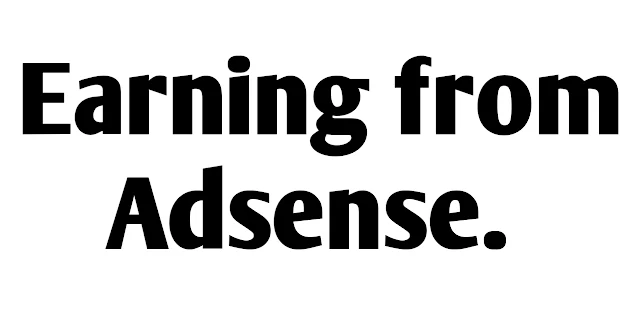Why Finance Knowledge Is So Important

Where to Invest ?

How to earn from Google Adsense?

To earn from Google AdSense, you need to follow a systematic approach to set up your platform and optimize it for revenue generation. Here’s a step-by-step guide on how to earn from AdSense:
1. Create Quality Content.
Start a Website/Blog or YouTube Channel: Choose a niche that you’re passionate about and start publishing valuable, original content. Ensure that the content is engaging and appeals to a target audience.
Consistency.
Regularly update your platform with new content to attract visitors and keep them engaged.
SEO Optimization.
Optimize your content for search engines (SEO) to improve visibility and attract organic traffic.
2. Sign Up for Google AdSense.
Eligibility:
Ensure your website or YouTube channel complies with AdSense policies. For example, your site must have a significant amount of unique content and must not violate Google’s policies on prohibited content (like adult material or violent content).
Apply for AdSense
Create an AdSense account and submit your site/channel for review. Google will verify that it meets their guidelines.Once approved, you can start displaying ads on your platform.
3. Place Ads on Your Platform
Ad Code Integration.
Google will provide you with an ad code that you can place on your website. For YouTube creators, ads are automatically placed once monetization is enabled.
Strategic Placement.
Place ads in positions that are visible to users but do not disrupt their experience. Common ad placements include the top of pages, within content, and sidebars.
4. Drive Traffic to Your Platform:
Content Marketing
Promote your content through social media, email newsletters, and SEO to attract more visitors to your website or YouTube channel.
Engage with Your Audience.
Encourage visitors to return by providing valuable content, fostering community engagement, and responding to comments.
5. Earn Money through Ad Interactions.
Clicks (CPC)
You earn money each time a visitor clicks on an ad displayed on your site.
Impressions (CPM)
You can also earn based on the number of impressions (views) an ad receives. This is especially useful for high-traffic sites.
Ad Engagement.
Higher engagement, either by clicks or views, leads to higher revenue. Therefore, the more traffic and interactions your content receives, the more you can earn.
6. Optimize Your Earnings:
Experiment with Ad Placement.
Try different ad placements and formats to find what works best for your audience. For instance, inline ads within content often perform well.
Use Responsive Ads.
Ensure that ads are optimized for both mobile and desktop to maximize earnings from all types of devices.
Focus on High-Value Content.
Content that attracts advertisers with higher bids (e.g., finance, technology) often results in better-paying ads.
7. Monitor Performance and Make Improvements.
Analytics and Reports:
Use Google AdSense’s reporting tools to track performance metrics like clicks, impressions, and revenue.
Test and Adjust.
Continuously analyze the data to adjust ad placements, content, and traffic strategies for better performance.
Optimize Loading Speed.
Ensure your website loads quickly. Slow-loading pages can lead to lower engagement and earnings.
8. Reach the Payment Threshold.
Payout Threshold.
AdSense has a minimum payout threshold of $100. Once your earnings exceed this amount, Google will send you the payment through your selected payment method (e.g., bank transfer).
Tax Compliance.
Ensure you complete the tax information on your AdSense account and comply with local tax regulations.
Avoid Click Fraud.
Never click on your own ads or encourage others to do so artificially. This is against AdSense policies and could result in account suspension.
Maintain Policy Compliance
Regularly review AdSense policies to ensure your content continues to meet the required guidelines.
Tips to Maximize AdSense Earnings.
Create High-Quality, In-Demand Content.
Content that attracts consistent, targeted traffic will have higher ad value.
Increase Page Views and Traffic.
The more traffic you have, the more opportunities for ad clicks and impressions, which increases earnings.
Target High-CPC Niches:
Some niches, such as finance, technology, and health, often have higher Cost-Per-Click (CPC) rates.
Use Multiple Ad Types.
Experiment with different ad formats like text, display, and video ads to find what resonates with your audience.
By consistently driving traffic, optimizing your ad placements, and following best practices, you can generate steady income from Google AdSense.
What is Dropshipping ?

What is social media marketing.?

These days you must have heard the name of social media marketing because social media marketing has become very popular. If you are curious about what is social media marketing and you want to know about social media marketing in detail then you can know by reading this article of mine.
To understand social media marketing better, we should first understand what social media is and how it works.
How bloggers are making money from blog?

What is website?

Today, if we want to search anything on the Internet, then through which website we get it, and there are so many websites available on internet. Now a day everyone knows what is website. Website works on internet. There is no existence of any website without internet. When we hear about a website, lot of questions arise in our mind like what is a website actually and how does it work. If you also have these type questions in your mind, then from this article of mine, you will get the answer of all your these questions.
What is Active and Passive income?

Sources of Active income.
What is Adsense?

Uses of AdSense.
How Adsense work ?
Which is better Job or Business

What we have to do business or job this is tough questions and the answer also this question is very hard, if you want to be a rich, or you want to earn a lot of money then there are only two options, first JOB because it is easy and very simple way to earn money in your life, and second opinion is business. You can also earn money from business, but what would be the best option fro earning money in your life.
What is Businessmen And entrepreneur.

"Business" refers to the activities involved in the production, buying, and selling of goods and services to meet the needs of consumers. It includes everything from small local shops to large multinational corporations. Businesses aim to generate profit by providing products or services that customers need or want.
An "entrepreneur" is an individual who starts and runs their own business, taking on financial risks in the hope of making a profit. Entrepreneurs are often seen as innovators, bringing new ideas, products, or services to the market. They play a critical role in the economy by creating jobs, driving innovation, and fostering economic growth.
The distinction between a businessperson and an entrepreneur is nuanced but significant, as it highlights the difference in roles, objectives, mindset, and approaches to the market.
1. Mindset and Approach.
Businessperson.
A businessperson typically operates within an established system. Their goal is to sustain and grow the business by refining existing processes and maximizing efficiency. They often adopt proven strategies and methods to manage their businesses effectively. For example, a businessperson might run a franchise, take over a family business, or manage a company in a traditional industry. The focus is usually on profitability, efficiency and market competition.
Entrepreneur.
An entrepreneur, on the other hand, is driven by innovation. They are usually the creators of new ideas, products, or business models. Entrepreneurs often identify gaps in the market or envision something that doesn't yet exist and create a business around that vision. They are risk-takers and problem-solvers, willing to challenge the status quo. They often embrace uncertainty and are more focused on disruption, growth, and scalability.
2. Risk Tolerance
Businessperson
Generally, businesspeople take calculated risks but tend to prefer environments where risk is minimized. They are often more conservative in their approach and work to ensure the business remains stable. They deal with known variables, such as operating costs, market competition, and customer demand.
Entrepreneur
Entrepreneurs are typically more comfortable with taking higher risks. They venture into uncharted territories, where the outcomes are uncertain. The success of their business idea may depend on external factors such as market trends, customer acceptance, and technological advancements. Entrepreneurs often embrace the possibility of failure as a learning experience and are more willing to pivot their ideas or strategies.
3. Innovation and Creativity.
Businessperson.
Businesspeople are often more focused on executing existing ideas and refining them. They prioritize operational excellence, process improvement, and scaling a business that is already functioning. Creativity may be employed to enhance efficiency or competitiveness, but it's not necessarily central to their role.
Entrepreneur.
Entrepreneurs thrive on innovation and creativity. Their primary goal is to bring something new to the market—whether it's a novel product, service, or way of doing things. They often challenge traditional business models and seek to create value in unique ways. Entrepreneurship is closely tied to continuous innovation, often involving new technologies, trends, and methods.
4. Focus and Objectives.
Businessperson.
The main focus of a businessperson is to ensure profitability, sustainability, and growth within an existing business framework. They are often concerned with market share, efficiency, reducing costs, and increasing margins. The primary objective is to run a business in a way that consistently generates income and remains competitive.
Entrepreneur.
Entrepreneurs focus more on creating and expanding opportunities. Their goals often involve launching a new venture, scaling it rapidly, and potentially disrupting existing markets. Their objective may be less about short-term profitability and more about long-term growth and impact, often seeking to build something scalable and impactful on a larger scale.
5. Longevity and Exit Strategies.
Businessperson.
Businesspeople usually aim for the long-term sustainability of their ventures. Their goal may be to pass down the business to the next generation, maintain it for personal income, or gradually grow it over time. Exit strategies for a businessperson might involve selling the company or simply retiring and handing over management duties.
Entrepreneur.
Entrepreneurs often plan their exit strategies from the outset. Many entrepreneurs aim to build a business that can be sold, merged, or taken public (e.g., through an IPO). Their focus is on rapid growth, and they may look for opportunities to sell the business or move on to their next venture once they've achieved their goals.
6. Examples.
Businessperson.
A businessperson might be someone who owns and manages a retail store, a manufacturing company, or a franchise. They are involved in the day-to-day operations and work to optimize the business within a known market.
Entrepreneur.
An entrepreneur might be someone who starts a tech startup that disrupts the traditional industry, creates a new app, or launches an innovative product that didn’t previously exist. They create value by bringing something entirely new to the market.
7. Skills and Expertise.
-Businessperson
A businessperson is often skilled in management, operations, financial analysis, and market competition. They are adept at problem-solving within a defined business structure and excel in execution and process optimization.
Entrepreneur.
Entrepreneurs are typically skilled in creativity, innovation, and vision-setting. They are resourceful, adaptable, and have a strong sense of resilience. Entrepreneurs often possess strong leadership abilities and are driven by a passion for change.
Conclusion:
While both businesspeople and entrepreneurs are essential to the economy, they serve different roles. Businesspeople are essential for running and growing established businesses and ensuring economic stability. Entrepreneurs are the drivers of innovation and change, often responsible for introducing new products, services, and industries that push society forward.
A












